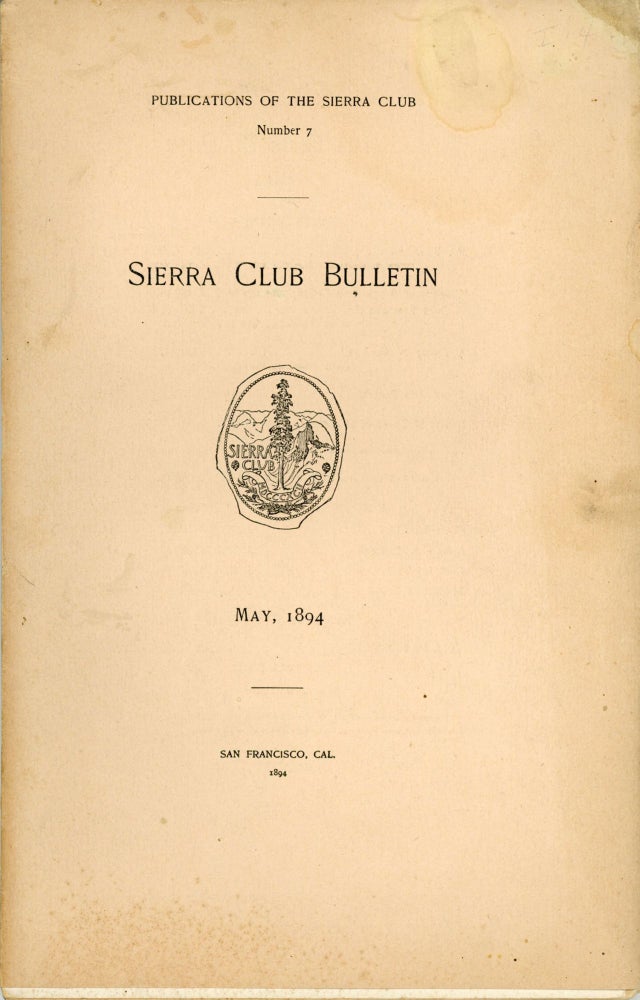Sierra Club Bulletin. San Francisco: Sierra Club, May 1894 (volume 1, number 4). 24.5x15.8 cm, single issue, 7 inserted plates, original tan wrappers printed in black, sewn. The fourth issue of THE SIERRA CLUB BULLETIN. Articles in this issue are: "Mount Tahoma. A Narrative of an Ascent of the Mountain by its Western Slope, Being an Exploration of Crater Peak and North Peak" by P. B. Van Trump, "Itinerary of a Route from Gentry's to Top of El Capitan and Yosemite Falls" by Elliott McAllister, and "A Tramp to Mt. Lyell" by Helen M. Gompertz. Van Trump's narrative is an account of the first ascent, in the summer of 1892, of the North Peak of Mount Rainier, aka Mount Tahoma; an active volcano in the Cascade Range that last erupted in 1894. Ms Gompertz and three others climbed Mt. Lyell, reaching the summit on July 9, 1892. Apparently, she and Ms Isabel Miller, the other lady in the party, were the first women to climb the peak, the highest in Yosemite National Park. THE SIERRA CLUB BULLETIN (1893 to date) is the single most important source of information on the human and natural history of the High Sierra. It is a primary source for narratives of exploration and early mountaineering in the Sierra and for information on conservation issues affecting the range. Additionally, it serves as a major repository for articles on Sierra history, geology, wildlife, and flora. During the 1890s, the Sierra Club's principal objective was "to explore, enjoy and render accessible the mountain regions of the Pacific Coast" and "to enlist the support of the people and the government in preserving the forests and other natural features of the Sierra Nevada." During this period, the club aided defeat of a proposal to reduce the boundaries of Yosemite National Park, advocated the establishment of the Sierra Forest Reserve (created 1893) and campaigned for the recession of Yosemite Valley to the federal government. A high percentage of the articles published in the early issues of the Bulletin reflected the club's effort to gather data on portions of the High Sierra, previously unexplored or seldom visited, to facilitate access to these regions by the public and to promote the high country from Tuolumne watershed south to the Kern as a wilderness area worthy of preservation as a public park. The systematic exploration of the High Sierra during the 1890s by club members, most notably those of Joseph N. LeConte and Theodore S. Solomons, provided details for the Sierra Club's maps of Yosemite Valley and the Central Sierra (items 298-300) and located the route for a high mountain trail from Yosemite to Kings Canyon, the latter leading to the establishment of the John Muir Trail and public perception of the central and southern Sierra crest as a single entity. For a useful history of the exploration of the High Sierra during this period, see Farquhar (1965), pp. [217]-38. A detailed account of Solomon's exploration of the High Sierra is in Shirley Sargent, Solomons of the Sierra: The Pioneer of the John Muir Trail (Yosemite, California: Flying Spur Press, [1989]). An excellent summary of the effort to locate, establish and construct the high mountain route from Yosemite to Kings Canyon is in Hal Roth, Pathway in the Sky: The Story of the John Muir Trail (Berkeley, California: Howell-North Books, [1965]). The contents of the Sierra Club Bulletin, indexed by volume and by author, are listed in Dorothy H. Bradley and George Shocat, Fifty-Seven-Year Index: Sierra Club Bulletin, 1893-1949 (San Francisco: Sierra Club, 1952). Some light tanning and soiling to wrappers, a very good untrimmed and unopened copy. (#167211).
No statement of printing.


